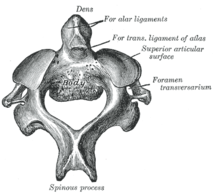Axis (cervical vertebra)
The axis is the second cervical vertebra (C2). The Latin word axis comes from the Greek ( Αξις ) and means axis . Together with the first cervical vertebra - the atlas - it forms the head joints and above all enables the head to be rotated. He is also called Epistropheus in Greco-Latin .
shape
The shape of the axis differs from all other vertebrae. The vertebral body is relatively large and massive. The most prominent feature is the spine or tooth of the axis ( dens axis ) on the top front (humans) or front (quadruped mammals) of the vertebral body. It provides ontogenetically the vertebral body of the atlas is situated exactly where this almost circular eddy the body lacks. The dens goes straight up from the top of the vertebral body, has an articulating surface on its front and back, and ends with a rounded tip.
On both sides of the axis there is a short transverse process ( processus transversus ), which, as is typical of the cervical vertebra , encloses a round opening ( foramen transversarium ) for the vertebral artery . The vertebral arch, which is also quite massive, adjoins the back, the end of which bears the short, forked spinous process (spinous process ). On the top and bottom are two articular processes ( processus articularis superior and inferior ) for the connection with the two adjacent vertebrae.
Joints
The joint between the axis and the atlas is the lower head joint . The axis with its two inferior articular processes articulates with the superior articular processes of the third cervical vertebra and forms a normal vertebral arch joint ( articulatio zygapophysialis ).
Injuries
Fractures of the second cervical vertebra account for around a fifth to a quarter of all cervical vertebrae injuries, around 60% of which are fractures of the dens axis. If an accident victim suspects a broken neck, intubation must be carried out carefully, preferably in a neutral position. The displaced vertebra is usually fixed from the front with the help of two lag screws (ventral compression osteosynthesis ). Atlanto-occipital dislocations can be quantified using the dens-basion interval. In a normal x-ray, the distance between the tip of the dens axis and the basion should be less than 12 mm.
When shooting in the neck - the painless killing of a severely injured animal - hunters take advantage of the special features of the axis because the spinal cord can be easily cut there. The same thing is possible with a hunting knife and is called " nodding off " with deer .
See also
Individual evidence
- ↑ a b c Walther Graumann, Dieter Sasse: Compact textbook anatomy. 2. Musculoskeletal System, Volume 2 . Schattauer Verlag 2003, ISBN 978-3-7945-2062-6 , p. 17 ff.
- ↑ Harald Tscherne, J. Kühn, Michael Blauth: Tscherne Trauma Surgery: Spine, Volume 3 . Gabler Wissenschaftsverlage 1997, ISBN 978-3-540-62480-6 , p. 88 ff.
- ↑ Basion-Dens Interval (BDI). Retrieved on April 3, 2020 (German).

